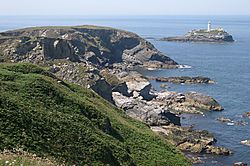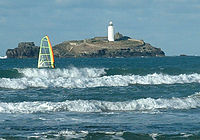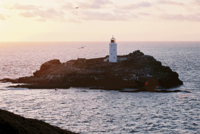Godrevy
| Godrevy | |
|
National Trust | |
|---|---|
 From the Knavocks to Godrevy Point | |
| Grid reference: | SW582430 |
| Information | |
| Website: | Godrevy |
Godrevy is a headland and coastal district in western Cornwall. Much of it belongs to the National Trust.
The name "Godrevy" (Cornish: Godrevi) means small farms. It is an area on the eastern side of St Ives Bay facing the Atlantic Ocean, and popular with both surfers and walkers. Offshore on Godrevy Island is a lighthouse maintained by Trinity House which is said to be the inspiration for Virginia Woolf's novel To the Lighthouse.[1] Godrevy lies within the Cornwall Area of Outstanding Natural Beauty (AONB) and the South West Coast Path runs around the whole promontory. There are several public car parks on the western side where the National Trust owns and operates a cafe.[2]
Godrevy Head
The headland (SW580430) is on the Atlantic coast on the eastern side of St Ives Bay and about three miles northeast of the town of Hayle. The nearest village is Gwithian, half a mile west beyond Godrevy Bridge across the Red River.
The promontory is roughly square in shape and faces north into the Atlantic occupying an area of approximately a square mile. In 1939, 320 acres and 5 miles of coastline were donated to the National Trust by D W Thomas of Gwithian, followed by a further 19 acres of land adjoining Godrevy Farm in 1962 by Nicholas and Charles Thomas.[1]
Godrevy Head has some of the best coastal heathland in Cornwall, with many species of plant, animal and insect life. Part of the headland, along with the coast to the east was designated as part of the Godrevy Head to St Agnes SSSI (Site of Special Scientific Interest) in 1951.[3]
The western side of the Godrevy Head is bounded by rocks to the north and a wide sandy beach to the south which is popular for surfing. At the north-western corner of the headland is Godrevy Point; at the north-eastern corner is Navax Point. The cliffs between the two points are approximately 220 feet above sea level.
On the northern side of the headland are two coves named Mutton Cove and Kynance Cove beyond which the Nathaga Rocks lie off Navax Point. On the eastern side of the headland are Castle Giver Cove and Fishing Cove.
South of Navax Point is an area of heath named The Knavocks which is managed by The National Trust. The grassland and gorse scrub is criss-crossed with footpaths and is home to many species of butterflies and birds, notably nesting stonechats. The Knavocks, like other coastal heathlands in Cornwall, is managed by regularly cutting back the gorse and by grazing, the National Trust having introduced a herd of ponies for the purpose.
Beyond Fishing Cove, the coast swings to the east towards Hell's Mouth and North Cliffs. The land here rises to approximately 290 feet, the highest point on this section of clifftop.
The cliffs, offshore rocks and coast around Godrevy Head form a renowned habitat for seabirds including cormorants, fulmar, guillemot, and razorbills and several species of gull. There is also a substantial population of grey seals throughout the year. Occasionally, bottlenose dolphins can be seen in the area.
Godrevy Island lies approx three hundred yards off Godrevy Point. The uninhabited island is the site of an operational Trinity House lighthouse (see below).
Seaward of Godrevy Island is a submerged reef known as the Stones which extends for approximately a mile across the eastern approach to St Ives Bay. Godrevy lighthouse was built to warn shipping of the danger posed by the reef.
Geology
The rocks at Godrevy are Devonian mudstones overlain with Quaternary ice age|ice age deposits. The mudstone was laid in a deep sea sedimentary basin and subject to seismic activity, forming turbidites. Under gravitational slumping the coarser material settled first followed by the finer material.[4]
Overlying the turbidites is a sequence of rocks laid down during recent ice ages, and Godrevy is considered to be one of the most important Pleistocene (2,588,000 to 11,700 years ago) sites in the south west of England. Mammal fossils are rare in Cornwall and a dog was found within the poorly sorted, course–grained sediments of head dated to 12,000 to 15,000 years ago. The earliest evidence of domestication is a dog, or wolf puppy, in a human burial site in Israel from 12,000 years ago. The earliest British domestic dog remains are from Starr Carr in Yorkshire dated to 9,538 (± 350) BP. In order to date the skeleton, and to test three hypotheses, part of a bone was sampled at the University of Oxford Radiocarbon Accelerator Unit using accelerator mass spectrometry (AMS).[5]
The three hypotheses were:–
- if the skeleton is in context with the geology (i.e. the same age as the head deposits), then the deposits are younger than previously thought,
- if the dating of the head deposits is correct than the dog is a very early example of domestication,
- if the skeleton is younger, it is not in context with the geology.
The dog skeleton dates to 1650 AD (± 30) which implies that it is possible for a recently dead animal to be within ice age deposits but leave no indication of how it happened. Fossil occurrence within ice age deposits need to be treated with caution, and skeletal remains need to be dated by AMS to provide their actual age and geological significance.[5]
Godrevy Lighthouse

Godrevy Lighthouse was built in 1858–1859. The Stones reef had always been a hazard to shipping and a lighthouse had been considered many times before 1858 but nothing came of plans until the SS Nile was wrecked on 11 November 1854, with the loss of all on board.[6] The lighthouse is a white octagonal tower, 86.0 feet (26.2 m) high and made of rubble, stone and mortar. The original light was a revolving white one, with a fixed red light below the main light, which could be seen over a 45-degree arc when a ship was in danger of the reef. This was later replaced by a red sector on the main light itself. Originally, the light was manned by three men at a time, but in 1934 the lighthouse was automated. The light flashes white/red every ten seconds, with the red sector only being visible in the arc of danger from the reef. The range of the light is around 12.0 miles (19.3 km). [7][1] Godrevy Light by Charles Thomas and Jessica Mann describes the history of this lighthouse and shows the many works of art it inspired.
The lighthouse is said to have inspired Virginia Woolf to write To the Lighthouse – although she locates the lighthouse in the Hebrides. She first visited on 12 September 1892, signing the visitors book, as did pre–Raphaelite painter William Holman Hunt who was in the same party. The lighthouse's visitor book, containing the signature of Virginia Stephen (Woolf), was sold at auction at Bonhams on 22 November 2011 for £10,250.[8]

Outside links
| ("Wikimedia Commons" has material about Godrevy) |
- Godrevy - National Trust
- Godrevy information at Trinity House
References
- ↑ 1.0 1.1 1.2 Thomas, Charles; Mann, Jessica (2009). Godrevy Light. Twelveheads Press. ISBN 9780906294703.
- ↑ Godrevy - National Trust
- ↑ "Godrevy Head to St Agnes". Natural England. 1989. http://www.sssi.naturalengland.org.uk/citation/citation_photo/1003195.pdf. Retrieved 6 December 2011.
- ↑ "Godrevy coastal exposures". CSM Virtual Museum. Camborne School of Mines. http://projects.exeter.ac.uk/geomincentre/excur-godrevy.htm. Retrieved 16 December 2012.
- ↑ 5.0 5.1 Crisp, G; Pirrie D, Shail R K, and Sabin R C. (2001). "The Godrevy dog; early canine or lost pet?". Geoscience in south-west England (Usher Society) 10 (2). http://www.ussher.org.uk/journal/00s/2001/documents/Crisp_et_al_2001.pdf. Retrieved 16 December 2012.
- ↑ Larn, Richard and Bridget (1997). "Vol 1 Section 4". Shipwreck Index of the British Isles. London: Lloyd's Register of Shipping. ISBN 0-900528-88-5.
- ↑ "Godrevy Lighthouse". Trinity House. http://www.trinityhouse.co.uk/lighthouses/lighthouse_list/godrevy.html.
- ↑ "Visitor;s book signed by Woolf is sold for £10,250". Western Morning News. 24 November 2011. http://www.thisiscornwall.co.uk/Visitors-book-signed-Woolf-sold-pound-10-250/story-13941635-detail/story.html. Retrieved 17 December 2012.
Further reading
- Godrevy Light by Charles Thomas with Jessica Mann, Truro: Twelveheads Press, 2009 ISBN 978-0-906294-70-3
- Godrevy Lighthouses - Worldwide Lighthouses
